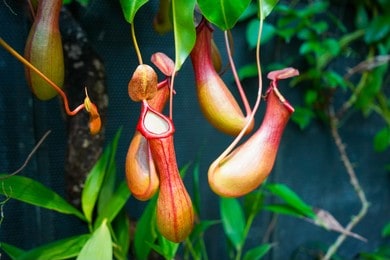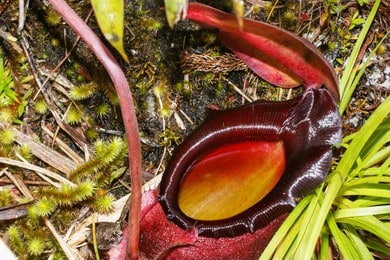
Nepenthes, or monkey cups as they are also known, are most prevalent in South East Asia, particularly the Borneo, Sumatra, and Philippine Islands. These species can be found in habitats ranging from high cloud forests to tropical lowland swamps. The pitchers (cups) on nepenthes, which are modified leaves that come in a variety of sizes and forms, are the major reason they are produced; the flowers are somewhat unimportant.
Table of Contents
Cultivation
Nepenthes are split into two categories for cultivation: highland varieties and lowland types. Highland require a minimum nightly temperature of 10 to 12 degrees Celsius and a maximum daytime temperature of 21 degrees Celsius. Lowland species require a nighttime minimum of 14C and a daily minimum of 22–25C. To achieve the best results, all of these plants need humidity levels of between 60 and 80 percent, thus a greenhouse or terrarium is the perfect environment for them. Similar to several orchid species, these plants should never be allowed to stand in deep trays of water. Instead, they do best when planted in hanging baskets or pots that are watered from above. They also benefit from the light foliar feed with SB plant invigorator, which is available on the Internet.
Light
Nepenthes thrive in bright or light shaded areas; however, direct full sun should be avoided since it might scorch the leaves. For the duration of the summer, 50% shade cloth will be needed if kept in a greenhouse.
Feeding

It works well to not go over this because too much feed can make the plants lethargic and produce fewer pitchers. It’s always preferable to underfeed! We give our nepenthes a foliar feed by way of a light spray with foliage pro or SB plant invigorator once every two weeks year-round with good results.
It may be worthwhile to invest in a humidifier if you intend to raise a sizable collection of these unique plants in a heated greenhouse.
The optimum location for nepenthes in the home would be a windowsill in the kitchen or bathroom, as well as a heated conservatory. Hybrid plants, of which there are many, typically appear to thrive in the home. Both N. x Ventrata and N. Sanguinea appear to thrive inside.
Compost
The optimal time of year to repot these plants is from March to May, using our COM4 or COM7. When re-potting, be cautious with the plant and roots as you remove the old compost because they are very brittle and easy to harm. Also, never pack the new compost too firmly around the plant and roots when you add it. A combination of medium grade pine bark, perlite, and long fibre sphagnum moss has been shown to be a suitable growing medium.
Taking stem cuttings in the early spring or sowing young, fresh seeds on a bed of peat and sharp sand for propagation. A heated propagator is necessary for striking cuttings and for good seed germination once it is big enough to handle the transfer to the above-recommended media.
Are Nepenthes easy to grow?
These pitchers develop on steep hills between 0 and 1600 meters above sea level and will climb trees (up to 30 meters or 100 feet). This pitcher is among the easier-to-grow pitchers due to the vast variety of elevations it can grow in.
Is pitcher plant and Nepenthes the same?
Nepenthes, the only genus in the family Nepenthaceae of carnivorous pitcher plants, is also known as the tropical pitcher plant or the monkey cup (order Caryophyllales). There are about 140 species, most of which are indigenous to Australia, Madagascar, and Southeast Asia.
Should I trim my Nepenthes?
You might be curious about pitcher plant pruning for tropical plants like Nepenthes, or Monkey Cup, if your plant is a pitcher plant. The directions are essentially the same. Trim off pitchers and leaves as they naturally wither to maintain the plant healthy.
Summary
Always utilize rainwater, and in the winter, make sure it’s not icy cold.
Keep the compost barely damp, never drenched.
For these plants, a light, humid location is ideal; extremely hot, dry conditions are actually not acceptable.
Once every two weeks, foliar feeding can help develop strong, healthy plants.
If necessary, prune climbing stems every two years.
